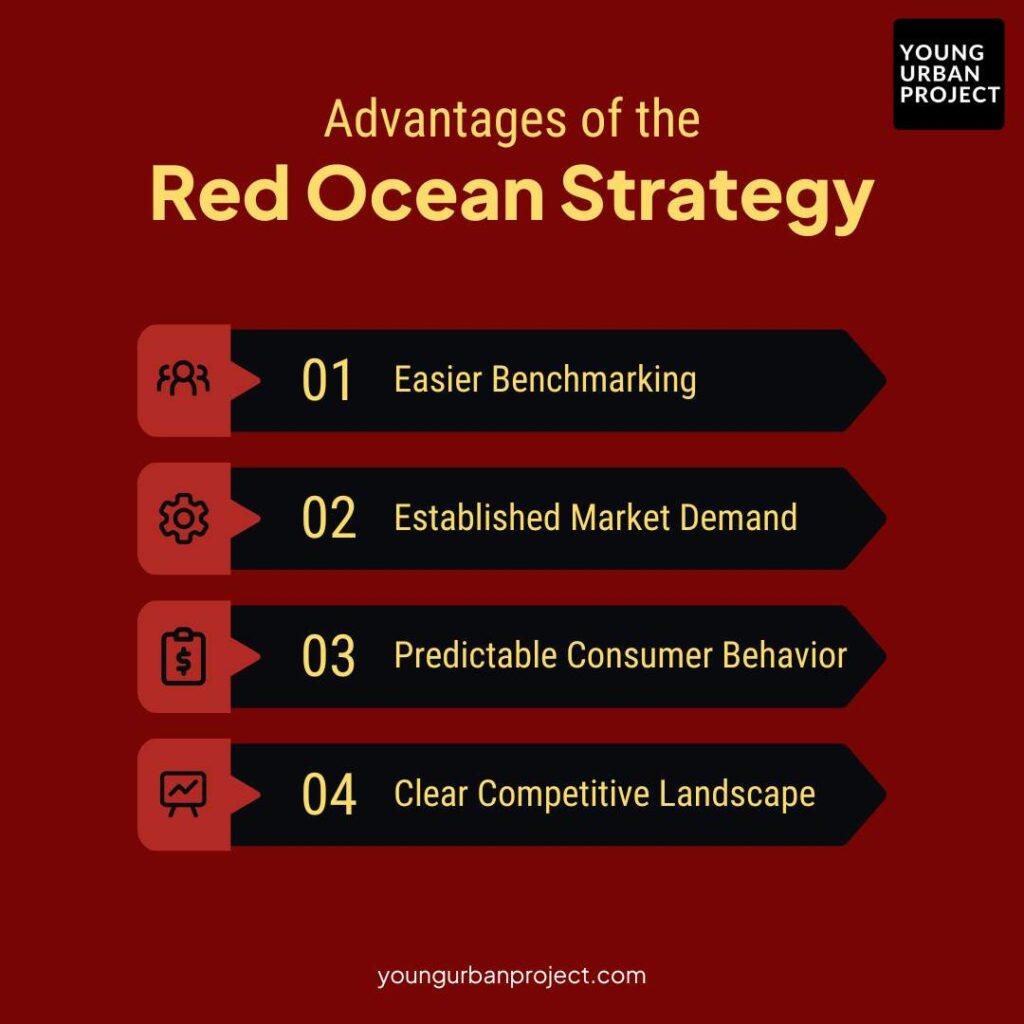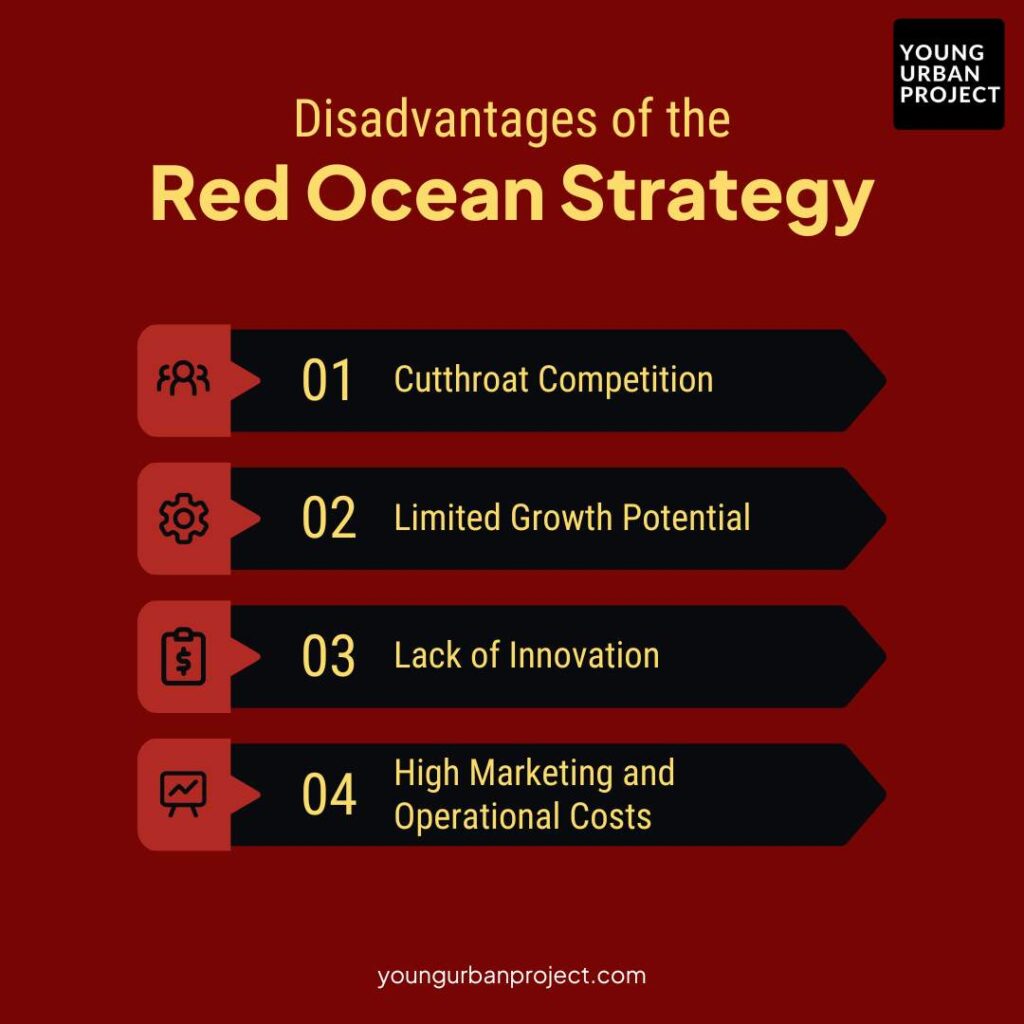Ever feel like your business is swimming with sharks, all fighting for the same customers? That’s the Red Ocean Strategy in action. In today’s crowded marketplace, most companies battle in these bloody waters, competing fiercely for limited market share while watching their profits shrink.
Table of Contents
Despite the rise of innovative approaches, the Red Ocean Strategy remains incredibly relevant in 2025. Most businesses still operate in established markets with clear boundaries and rules, from retail giants fighting for shoppers to restaurants competing for diners in your neighborhood.
In this blog, we’ll explore what Red Ocean Strategy really means, compare it with alternatives, look at real-world examples, and provide practical advice for businesses navigating competitive waters. Whether you’re struggling to survive or looking to thrive in a crowded market, understanding these concepts will help you make smarter business decisions.
What is the Red Ocean Strategy?
Red Ocean Strategy refers to competing in existing, crowded markets where industry boundaries and rules are clearly defined. First described by professors W. Chan Kim and Renée Mauborgne in their 2005 book “Blue Ocean Strategy,” the term “red ocean” symbolizes the bloody competition as companies fight over the same customers. Instead of creating new demand, businesses focus on beating rivals by offering lower prices, better features, or improved service – often at the expense of profitability. The concept highlights how industry structure fundamentally shapes the strategies companies pursue, usually constraining them to compete on the same factors as everyone else.
Characteristics of red oceans:
1. Intense competition: Companies battle aggressively for market share, often leading to price wars and diminishing profits. Think smartphone makers constantly undercutting each other or airlines competing solely on ticket prices.
2. Defined industry boundaries: Clear lines exist between different industries, with companies rarely crossing these boundaries. Traditional banks stick to banking, retailers to retail, creating predictable competitive landscapes.
3. Known market space: The total available market is well-understood and often grows slowly. Companies focus on capturing larger portions of existing demand rather than generating new customers or needs.
4. Zero-sum game: One company’s gain typically comes at competitors’ expense. When Ford sells a truck, that’s one customer Toyota didn’t get – creating constant pressure to outperform rivals.
🔴 Red Ocean vs 🔵 Blue Ocean: What’s the Difference?

| Point of Comparison | Red Ocean Strategy | Blue Ocean Strategy |
| Market Type | Known market space | New, untapped market space |
| Competition | Fight to beat the competition | Make the competition irrelevant |
| Strategy Focus | Capture a bigger share of existing demand | Create and grow new demand |
| Approach | Compete on price or features | Offer something completely new or different |
| Goal | Outperform rivals | Create value without worrying about rivals |
| Innovation | Often limited or incremental | Encourages bold, fresh innovation |
| Cost Strategy | Choose between low cost or differentiation | Achieve both: low cost and differentiation |
| Industry Rules | Follow existing industry rules | Redefine the rules or create new ones |
| Risk Level | Lower, but with slower growth | Higher, but with potential for big rewards |
| Example | Competing hotels, phone brands | Cirque du Soleil, [yellowtail], Airbnb (in early days) |
When to Use a Red Ocean Strategy
1. Situations where red ocean strategies make sense
Red Ocean strategies work well when your company has strong competitive advantages like unique technology, superior distribution networks, or cost efficiencies. They’re smart choices in stable industries with predictable growth and when you have resources to withstand competitive pressure or outspend rivals to gain market share.
2. Industries naturally suited for red ocean tactics
Mature industries with standardized products like appliances, fast food, and basic consumer goods naturally favor red ocean strategies. These markets have established customer expectations and purchasing patterns. Highly regulated sectors like banking, insurance, and utilities also tend toward red ocean competition due to structural constraints.
3. Why some businesses prefer competing for market share
Many businesses stick with red oceans because they understand these markets deeply. They’ve built expertise, relationships, and infrastructure specific to these industries. There’s comfort in competing where rules are known, risks are calculable, and proven tactics exist. Plus, capturing market share from rivals offers immediate revenue without the uncertainty of creating new markets.
Strategic Moves in Red Oceans
1. How companies compete: outperforming rivals
In red oceans, companies win by doing things better, faster, or cheaper than competitors. This means optimizing every business function – from production to customer service. Success comes from understanding competitors’ weaknesses and exploiting them while protecting your own advantages through constant improvement and strategic positioning.
2. Tools used: pricing, product differentiation, branding
Companies use competitive pricing strategies like value-based pricing or strategic discounts to attract price-sensitive customers. Product differentiation adds unique features or quality improvements that justify premium prices. Strong branding creates emotional connections with customers, making them less likely to switch even when competitors offer lower prices.
3. Role of innovation in crowded markets
Even in crowded markets, innovation matters – but it’s usually incremental rather than disruptive. Smart companies focus on efficiency innovations that lower costs or convenience innovations that improve customer experience. Innovation in marketing, distribution, or customer service can create meaningful advantages when product differentiation is difficult.
4. Market penetration vs market creation
Market penetration focuses on selling more existing products to current customers or winning competitors’ customers through better value. This approach leverages established systems and customer understanding. Market creation, while riskier, identifies unserved needs within existing markets, creating new segments without completely abandoning familiar territory.
Advantages of the Red Ocean Strategy

1. Easier Benchmarking
With well-defined competitors and industry standards, you can easily track your performance. Metrics like market share, sales growth, and customer acquisition costs can be directly compared to industry averages and specific competitors, giving clear feedback about your competitive position and helping identify improvement areas.
2. Established Market Demand
You don’t need to convince customers they need your product category – they already know it exists and understand its value. This eliminates the expensive and uncertain process of market education. Sales cycles are typically shorter, and marketing can focus on your specific advantages rather than explaining basic product benefits.
3. Predictable Consumer Behavior
Customer preferences, buying cycles, and price sensitivities are well-documented in established markets. This predictability allows for more accurate forecasting, inventory management, and marketing planning. You can analyze competitors’ successes and failures to understand what works without making costly mistakes yourself.
4. Clear Competitive Landscape
Knowing exactly who your competitors are lets you directly target their weaknesses while protecting your strengths. You can monitor competitors’ moves in real-time and adjust your strategies accordingly. Competitive analysis frameworks work best when rivals and competitive factors are clearly defined.
Disadvantages of the Red Ocean Strategy

1. Cutthroat Competition
The intense rivalry forces continuous price cutting and increased spending on customer acquisition. As competitors match your every move, advantages become temporary, creating a treadmill of investment with diminishing returns. Many companies find themselves trapped in cycles where nobody truly wins.
2. Limited Growth Potential
Your growth is constrained by overall market size and competitors’ strength. Once markets mature, growth often slows to single digits, making significant expansion difficult without taking substantial share from entrenched competitors. Market saturation means each new customer becomes progressively more expensive to acquire.
3. Lack of Innovation
Red ocean thinking encourages safer, incremental improvements rather than breakthrough innovations. Companies focus on matching competitors’ features instead of solving new problems. This defensive mindset can cause businesses to miss emerging opportunities and leave them vulnerable to disruptive newcomers from outside the industry.
4. High Marketing and Operational Costs
Standing out in crowded markets requires constant spending on advertising, promotions, and sales efforts. Companies must continuously invest in operational efficiencies to maintain cost competitiveness. These escalating expenses often consume potential profits, creating a situation where even market leaders struggle for healthy margins.
Industry Examples of Red Ocean Strategy
1. Nike in the Sportswear Industry
- Industry: Athletic Apparel & Footwear
- What’s the Red Ocean Move?
Nike competes in a hyper-competitive market dominated by big names like Adidas, Puma, Under Armour, and Reebok.
Instead of creating a new niche, Nike aggressively invests in endorsements (Michael Jordan, Serena Williams), high-budget advertising, and product innovation to outperform existing rivals. - Why it’s Red Ocean:
The market is already crowded. Nike’s strategy is about beating competitors for market share, not creating new demand.
2. McDonald’s in the Fast Food Industry
- Industry: Quick-Service Restaurants
- What’s the Red Ocean Move?
McDonald’s constantly tweaks its menu (McCafé, healthy options), upgrades service (digital kiosks, delivery), and competes on price, speed, and convenience against Burger King, KFC, Subway, etc. - Why it’s Red Ocean:
It’s a cutthroat market with limited differentiation. The goal is to out-market and out-serve competitors.
3. Samsung in the Smartphone Industry
- Industry: Mobile Phones
- What’s the Red Ocean Move?
Samsung directly competes with Apple, Xiaomi, and others by launching multiple devices per year across price segments, investing heavily in tech innovation (like foldables), and flooding the market with options. - Why it’s Red Ocean:
The smartphone industry is saturated and innovation-driven, making it a classic Red Ocean battle.
4. Colgate in the Oral Care Industry
- Industry: Personal Care (Toothpaste Segment)
- What’s the Red Ocean Move?
Colgate constantly launches new variants—whitening, herbal, kids’ flavors, etc.—to compete with Sensodyne, Pepsodent, Oral-B. - Why it’s Red Ocean:
The goal is defending shelf space and brand loyalty in an already crowded space.
5. Ola in India’s Ride-Hailing Industry
- Industry: Transportation (Cab Aggregators)
- What’s the Red Ocean Move?
Ola battled Uber directly on pricing, offers, driver incentives, and regional expansions. - Why it’s Red Ocean:
The Indian ride-hailing market became a price war zone, with no clear differentiation—just survival of the fittest.
Why You Should Consider Moving Away from Red Oceans
1. The Limits of Competing in Known Markets
In a red ocean, growth becomes hard after a point. There are only so many customers to win over. Even if you beat one competitor, another one shows up. Profits go down because companies keep lowering prices or spending more on ads. It becomes a cycle that doesn’t allow long-term, healthy business growth.
2. Rise of Saturated Industries in 2025
Many markets have become overcrowded. Almost every product or service already exists, and most companies offer similar things. Whether it’s food delivery, fashion, or tech tools, the choices are endless. That makes it very hard for new businesses to survive unless they bring something fresh or totally different to the table.
3. Risks of Relying Solely on Red Ocean Thinking
Sticking only to the red ocean strategy can stop your business from growing. You might win short-term battles, but long-term success needs new ideas. If you only focus on beating the competition, you might miss chances to create something new that people actually want but haven’t seen before. That’s a risky game.
How to Shift from Red to Blue Ocean Strategy
(A simple guide to help you move from competing in crowded markets to creating new ones.)
1. A Blue Ocean Perspective: Seeing the Big Picture
To move out of a red ocean, stop thinking only about beating rivals. Start by asking: What do customers really need that no one is offering? Look beyond your industry rules. Sometimes, a small shift in how you think opens up a completely new market that others haven’t seen yet.
2. Market-Creating Tools with Actionable Guidance
Use tools like the Strategy Canvas or Four Actions Framework from the Blue Ocean Strategy book. These tools help you understand where the crowd is and how to step away from it. They guide you in finding gaps in the market and designing smart, bold moves to fill those gaps.
3. Injecting Humanness and Creativity into Strategy
Blue oceans are not just about smart business moves—they’re also about real human needs. Think about how your product or service can simplify life, save time, or spark joy. The more emotionally connected your idea is, the more it will stand out. Innovation often starts with empathy.
Case Studies of Successful Transitions
- Yellowtail simplified wine and reached casual drinkers.
- Cirque du Soleil mixed circus and theater, creating a brand-new experience.
- Apple’s iTunes changed how people bought music.
All of them stopped copying competitors and instead focused on something new that people didn’t even know they wanted yet.
How to Compete Successfully in a Red Ocean
(If you’re staying in a red ocean, here’s how to do it smartly.)
1. Embrace Operational Excellence
Make your operations smooth and cost-effective. The goal is to deliver value without waste or delays. When you run a tight ship, you save money, improve service, and stay competitive—even in a tough market. In red oceans, efficiency is one of your biggest advantages.
2. Leverage Customer Loyalty Programs
In crowded markets, keeping your existing customers is just as important as gaining new ones. Loyalty programs, special perks, and personal touches can keep people coming back. If customers feel valued, they’re less likely to switch—even if a competitor offers a cheaper deal.
3. Optimize Cost Without Compromising Value
Cutting costs doesn’t mean cutting corners. Look for smart ways to save—like automating tasks or streamlining suppliers—while still delivering great products or services. When you balance quality and cost well, you stay strong in price wars without hurting your brand.
4. Adopt a Hybrid Approach: Differentiation & Cost Leadership
Don’t just pick between being cheap or being unique—find ways to do both. Offer something that feels special but doesn’t break the bank. This mix of standing out and staying affordable helps you stay ahead in a crowded market where everyone is trying the same old tricks.
Also Read: Live Performance Marketing Course
Conclusion
The Red Ocean Strategy is all about competing in crowded markets by trying to beat rivals for a bigger piece of the existing demand. While it can still work in 2025, especially in stable industries, it also comes with many challenges like price wars and slow growth. Business leaders need to decide if fighting in a red ocean is worth it—or if it’s time to explore new, untapped markets.
The idea was made famous by Chan Kim and Renée Mauborgne, who encouraged companies to stop competing and start creating. Whether you choose red or blue, your strategy should fit your business goals—not just follow trends. Choose wisely.
Which Strategy is Right for Your Business?
There’s no one-size-fits-all answer. Some businesses thrive in red oceans by being highly efficient. Others grow faster by moving into blue oceans. Think about your goals, resources, and market. Do you want to compete better—or create something completely different?
Red or Blue choose based on goals, not trends. Just because “blue ocean” sounds cooler doesn’t mean it’s right for you. Don’t follow trends blindly. Pick a strategy that fits your long-term vision. Whether red or blue, the goal is to build something valuable, sustainable, and meaningful for your audience.
FAQs: Red Ocean Strategy
1. What is Red Ocean Strategy in simple words?
Red Ocean Strategy is when many businesses fight over the same customers in a market. They try to beat each other by lowering prices or adding features. It’s like a crowded place where everyone is competing to grab a bigger share of the same market.
2. How is Red Ocean Strategy different from Blue Ocean Strategy?
Red Ocean is about competing in a market that already exists. Blue Ocean is about creating a new market where there’s no competition. In red oceans, companies fight over the same buyers. In blue oceans, businesses try to offer something new and different.
3. Is Red Ocean Strategy still effective in 2025?
Yes, it can still work in 2025. Some markets are very stable, and competition is the only way to grow. If done right, companies can still make profits by improving quality, cutting costs, and staying efficient—even in crowded spaces.
4. Can a company use both red and blue ocean strategies?
Yes, a business can use both. A company might compete in a red ocean for one product, while creating a blue ocean for another. It depends on the market and business goals. Smart companies often mix both to grow in different ways.
5. What are some real-world examples of the Red Ocean Strategy?
Examples include Microsoft in the software industry, hotels fighting on price and service, and AI companies launching similar tools. These businesses all compete in markets where many others offer the same thing, and the goal is to win more customers than the rest.
6. What are the biggest challenges of using a Red Ocean Strategy?
The main problem is high competition. It can be hard to grow or make good profits when everyone offers the same thing. Price wars, low margins, and customer churn are common. You must keep improving just to stay in the game.

